Some notes on
early Flatcoats in Finland
By Kenneth Kankkunen (jan 2019)
The very first Finnish Flatcoat
The first Flatcoat arrived in Finland 1967. It was a gift from the famous Swedish breeder Mrs. Brit-Marie “Bat” Brulin. Bat always stayed with us when showing her dogs in Finland. In 1965 she arrived at the Helsinki International Dog Show with a newly imported Flatcoated, Downstream Hestia. It was love at first sight when “Hessie” outran our Labradors with her feathering flying. Bat noticed my new enchantment and two years later she brought me a puppy named Puhs Hera from Hessie’s first litter by Blakeholme Jamie.
Puha Hera, photo Hannele Larsson
Hera was very unlike our Labradors; not being part of the flock. She developed her own routines. She used to patrol our premises and kept gypsies selling laces away while the postman was welcome. And after 3 p.m. she laid down at the gate waiting for my father to arrive from the job. In the winter when the wind was whirling snow at -15 centigrades and the Labs stood howling outside the door, Hera laid down in the snow, put her nose under her tail and was slowly covered by the drifting snow, perhaps showing some of her Newfoundland ancestry.
Hera was an extremely strong personality and being “not-of-the-flock” finally lead to a confrontation with the flock leader, my mother’s foundation Labrador bitch coming from genuine Mansergh blood and that is thick. The matured newcomer did not accept the leadership of the old matron anymore and after some sewing the two had to be kept apart. The Lab suffers more as it takes a strong grip whereas the Flat goes on like a sewing machine. Finally, I had to take the hard decision to give the five years old Hera to a friend of mine, working and living at an orphanage. After the relocation she was evidently happier having her own flock – the kids.
To gain her Sh Ch title Hera had to pass some of the tests designed by the KC for Retrievers as described later. Of course I opted for the cold game test as I had done with our Labradors previously. During training she suddenly started to refuse game. Due to my negligible experience I could not overcome the problem and we had to do the blood scent test instead. Soon the problems in the flock began and Hera´s abilities were not tested any more. In those early days my family had no such contacts with shooting people that would have given opportunities to test our dogs at real gundog work.
Hera had three litters, the first by Ryshot Copper Fire. Unfortunately, this litter had a bad HD status and no dogs were used at stud. Nevertheless, this mating produced the first Finnish Flatcoated Int. Sh. Ch., Rolls i Vassen. I Vassen (“in the weeds”) was my mother´s and mine joint suffix. The next time Hera was mated to Stolford Sepoy producing some nice offspring, e.g. Akvavitix i Vassen winning BiS at the retriever special in 1975. The same year he was the first Flatcoated to get a 1st prize at the retriever test which qualified for entering a field trial. The result, however, was a round zero. A brother of Akvavitix, Asterix i Vassen was mated to Jennifer (Puhs Herakles − Puhs Evoe) producing Mollyfer, the foundation bitch for Tapio Takala´s outstanding Taka-Tapiolan working line.
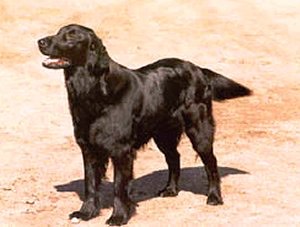
Kajsa I Vassen. Photo: Mikael Lindroos Hilwas Mercury. Photo: Tuula Rajala
In her last litter 1974 Hera was mated to Wood Man. I kept a bitch puppy myself named Kajsa i Vassen, producing Harald and Helga, from which stems several outstanding working lines, f.e. the descendants of Hilwas Chevrolet and Hilwas Mercury, the foundation bitch for Tuula Rajalas Blackpicks working line. My original stock was later acquired by Christina Helenius with the Hilwas prefix. Still today there are breeders maintaining Kajsa´s - and consequently Hera´s - straight bitch line 50 years later. For me this is also a proof of how excellent qualities Wood Man brought into the Finnish Flatcoats. As a breeder I was simply fortunate.
Ten years of struggle for the working Retriever
Retrievers as well as field trials have a rather short history in Finland. A few Labradors and Goldens were occasionally imported in the forties and fifties as pets, some of which may have been used for shooting purposes although no evidence exists. The owners were wealthy people of the high society living at private estates with high fences. In the early sixties the Retrievers started conquering Finland. First Labradors, then Goldens, then Flatcoats and so on. The Finnish Retriever Club was established in 1963.
In those days the Retriever was considered a pet. The Finnish Kennel Club gave it gundog status as late as 1969. Breeders were generally well-educated urban people living near the biggest cities and only a few had some connection to the countryside and shooting opportunities. So in the sixties Retriever people gathered at the shows. This led to a show orientated generation of breeders which later on postponed the interest in field trials. In the early seventies 2−3 cold game field trials were arranged annually, some of which had to be called off due to too few entries (min. 5). Not until the late seventies there was some increase of interest in field trials. The real boom came in the beginning of the eighties when an entirely new generation of breeders and handlers emerged. Many of these were young people from the countryside who had been shooting with other breeds.
Through the seventies the Retriever wasn’t recognized by shooting men who preferred the German pointer. The Finnish Retriever Club was not that keen either to promote the Retriever as a gundog, due to the orientation of the breeders. Hardly anyone bought a puppy for shooting purposes. They all wanted a pet; a Labrador or Golden. But exceptions existed which I will revert to later. The Flatcoated was next to unknown. I remember how my mother and I sold our first Flatcoated litters by calling people waiting for a Labrador (usually over a year) and offering a Flatcoated instead. This I had to do still in the early eighties. I cannot remember anybody complaining. Instead most of these people became advocates of the Flatcoated for life. They established the Finnish Flatcoated Retriever Club in 1982.
All through the seventies a number of different tests were approved for the title of Sh. Ch. These were the obedience tests at shows, utility dog tests, the blood scent test (1200 meters) and finally also the newly introduced Retriever cold game test and Retriever cold game field trial. As Retriever owners in general were urban people and the few who worked their dogs, preferred “tidy” trials like obedience or utility dog tests and looked down at us fools messing with stinking carcass. It took us “fools” over ten years to convince the Finnish Retriever Club as well as the Retriever owners that the Retriever, however nice a pet or guide dog for the blind, is a gundog with the purpose to retrieve game. Finally, in 1982 the Finnish Retriever Club adopted a resolution stating that the only test qualifying for the title of Sh. Ch is the cold game Retriever test.
As the reader understands, the start for the working retriever and particularly the working Flatcoated in Finland was hard, long and rocky. I visited a training session with Peter Johnson in Västerby, Sweden in 1980 and equipped with all the know-how I could keep in mind arranged training sessions in Finland which resulted in a remarkable increase of field trial entries. The work done during the first half of the eighties culminated in the first Nordic Championship trial in 1986 in Finland when a Finnish Labrador won the championship. Also the successful Flatcoated Taka-Tapiolan Roi was in the Finnish team which finished second after Sweden. During the eighties a notable number of Flatcoats entered trials with good success. All this was accomplished by several training sessions with Swedish instructors and above all Peter Johnson himself visiting Finland two times.
”A historical training session in Sweden. Kenneth Kankkunen being the second from the left and Peter Johnson the second from the right. Stig and Kerstin Olsson in the middle.” (Photo: Lasse Söderström)
Some comments on Retriever tests and trials in Finland
In the late sixties The Finnish Retriever Club adopted the same test system as the Finnish Spaniel Club shortly before and this differed from the Swedish. A simple Retriever test was a qualifier to enter a cold game field trial. This guaranteed that totally incapable dogs were not entered at field trials. I remember judging in Sweden in the seventies, how people tried in vain to get the desirable Open Class 2nd prize for their otherwise made up Show Champions. This was a frustrating waste of time for the organizers as well as the judge.
The first cold game Retriever test was held in 1969. The test itself was a rather simple one, testing walking at heel, gun shyness, the retrieving of a cold bird from land and water and a 100 meter rabbit track. All this was actually a close copy of an early Danish B-trial. Today this test, further developed, is still a qualifier for entering the B-type (cold game) field trial. The first cold game field trial was held in 1970.
Rearing and shooting pheasants have been a well-hidden hobby of the high society for decades. The gundog breed clubs again have been run by middle class enthusiasts with no affiliation to these estates. That is why we have had to stick to cold game and we still do except for a few occasions of which later.
Finland is a country of vast wildernesses and thousand lakes, so why not have field trials at ordinary one-man wildfowling which is most common among thousands of Finns. This has actually been done when arranging the so-called practical field trial for one or two dogs required for the “Cold Game Champion” title. But the birds dropped during a day are far too few for an ordinary field trial for let’s say 12 dogs.
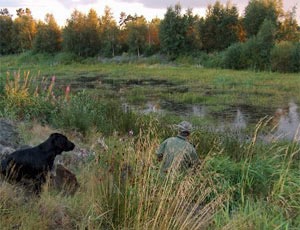
A shooting man waiting for the ducks to fly at sunset. His Flatcoated has to work its way through reeds and rushes, swim over the pond and hunt the runners through the bushes. This is where we need Retrievers in Finland. It is estimated that up to 200.000 shooting men are annually shooting appr. 450.000 waterfowl half of which were lost in 1972 due to lack of a retrieving dog. Today the estimate is 100.000 lost due to the introduction of trained Retrievers but many shooting men still do without.
(Photo: Sari Alho)
Around the turn of the century Finnish Retriever breed clubs had managed to establish contacts with the pheasant rearing estates and now a few so-called A-trials in British style are arranged annually. Only dogs qualified for Elite Class in a B-trial are entitled to enter these trials. In October 2018 I visited the Nordic Retriever Championship at a prominent Finnish estate. You could have been in Britain as well. Even the wardrobe of the crowd must have been bought at Bond Street. Of course the Labradors dominated. Out of 20 Retrievers 19 were Labs and only one Flatcoated. As usual the Norwegian Flatcoated, Nordic FT Ch Waternuts High and Mighty, was one of the few never to return without a bird. He was also given the Gun´s Choice.
The “real” working Flatcoated Retrievers
When talking working Retrievers you refer mainly to field trials. But there are Retrievers which do the real work and seldom, if ever, enter a field trial. Such were the early Finnish working Flatcoats. The first I knew about was a dog from the first litter out of Puhs Hera in -71 named Rolls I Vassen (later Int. Sh. Ch.) which went to a shooting gentleman living close to us. He was very pleased with his dog, but I never had the opportunity to see him at work. Apparently, he was not trained in the proper way and not steady at heel or gunshot like most other “real” working Retrievers in those early days. After Rolls, the same gentleman got a new dog from me named Harald (Hovhills Tornadoman – Kajsa i Vassen) which also worked to his full satisfaction. Eventually this dog became an Int. Sh. Ch. as well, being the third in Finland. He was never entered at a field trial, but I handled him through the cold game test for his Sh. Ch title with an afternoon’s training.
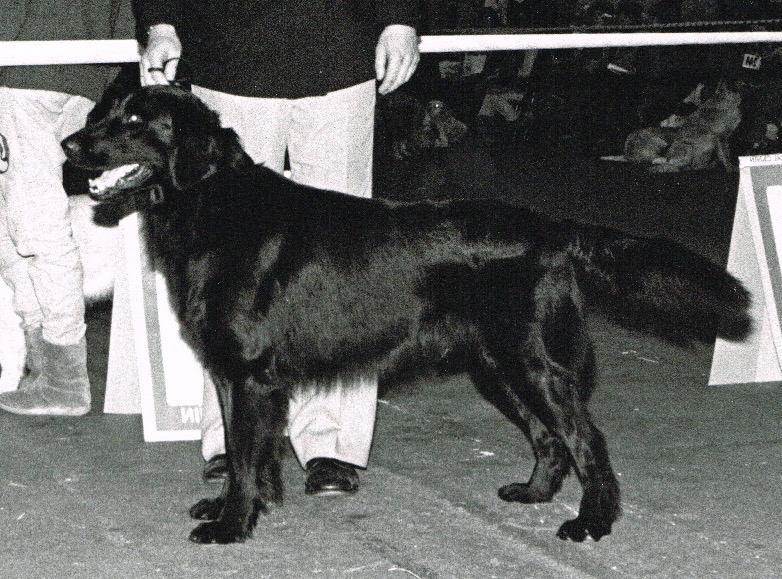
Int. Sh. Ch. Harald
In the early eighties we finally saw the birth of what I call the dual-purpose Flatcoated: Dogs that competed successfully at trials and being used for shooting as well. The classic dual-purpose concept was not that topical in those days as all Flatcoats looked more or less typical. My old friend Ingemar Borelius has given an excellent account on Finnish working Flatcoats from the eighties onwards. I will just give some examples of the early dogs I know of. Dogs which never became FT Ch stars but did a remarkable work in typical Finnish wildfowling: A man, his gun and his dog out there somewhere. Nowadays there are more and more ladies.
One of these “workhorses” was Tuomas (Tryggs Black Cock – Helga). Helga was a daughter of Kajsa i Vassen by Tornadoman. Tryggs Black Cock, nicknamed “Tjabbe” (Wood Man – Heronsflight Jade), was a gift presented to me in 1975 by the Swedish breeders Olle and Stina Högstedt. Unfortunately I got him at a most unfavorable period with much trouble and sorrow in our family and moving away. Unable to keep more than one dog, I kept Kajsa and gave Tjabbe to the orphanage to succeed Hera which had recently been put to sleep due to cancer.
Tjabbe was used only once on Helga in 1983 producing 7 dogs, all named according to the Finnish epos Seven Brothers. That was otherwise an unlucky litter – at least two were lost in traffic and the rest were never heard of – except for Tuomas, nicknamed “Makkonen”, which turned out to be an excellent worker. He even won the Finnish FCR Championship in 1986 beating the famous Roi. His master, later chairman of the Finnish FCR Club, Paul Ekblad used Makkonen extensively in the harshest conditions wildfowling in Finland could present. Shooting migrating long-tail duck (Clangula Hyemalis) and also eider duck (Somateria Mollissima) from the remotest small rocks off the coast of Gulf of Finland in October− November when sea water is near freezing. You cannot go out in storm but when the wind calms down, the swell can still be considerable. The wind and waves will carry the dropped bird far away in the open sea unless the dog is a fast swimmer. When the dog returns to the rock you cannot help the dog up because the cliffs are extremely slippery at the waterfront, but the dog has to crawl up itself. At the end of the day its nails are badly worn, even bleeding. Today shooting of long-tail duck is restricted and shooting at the outmost rocks has decreased. Tjabbe was no more used at stud, neither was his son Makkonen. That was not logics, just chemistry.
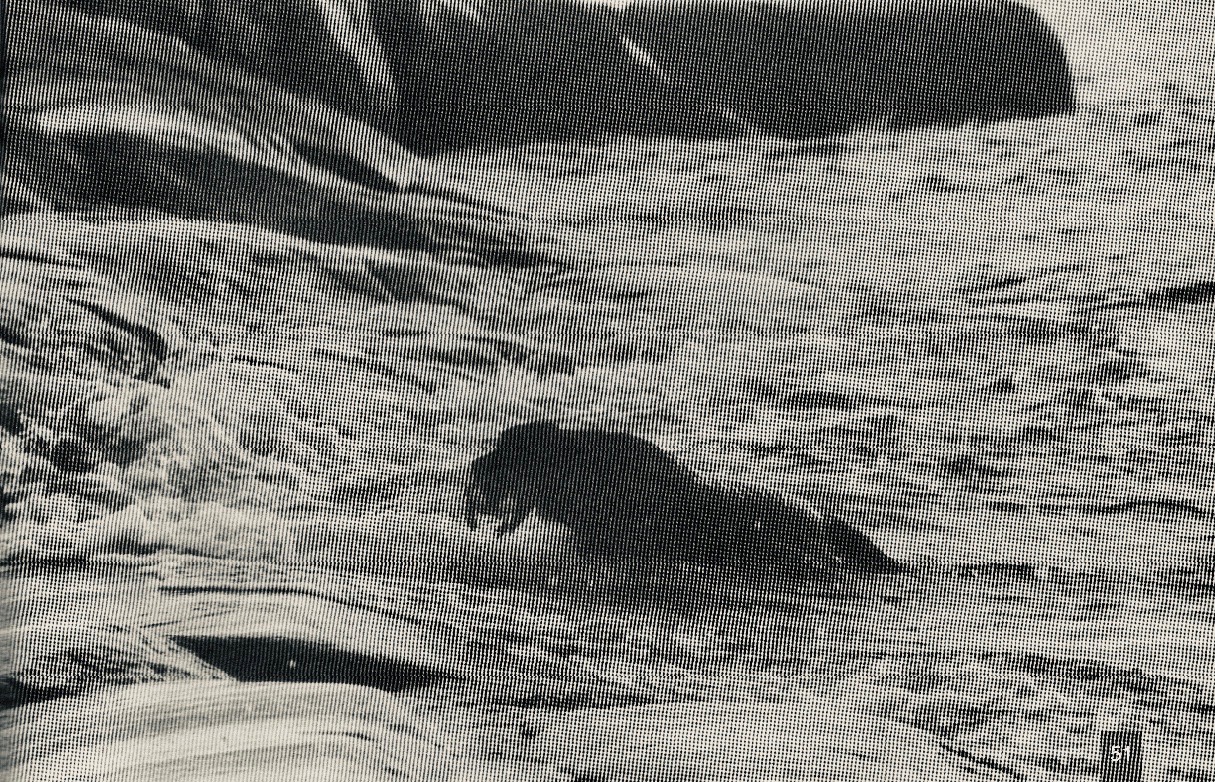
A Flatcoated retrieving a bird from open sea at a remote rock in heavy swell. Climbing up from water onto the very slippery rocks is a challenge which the dog has to manage itself. (Photo: Tommy Arfman)
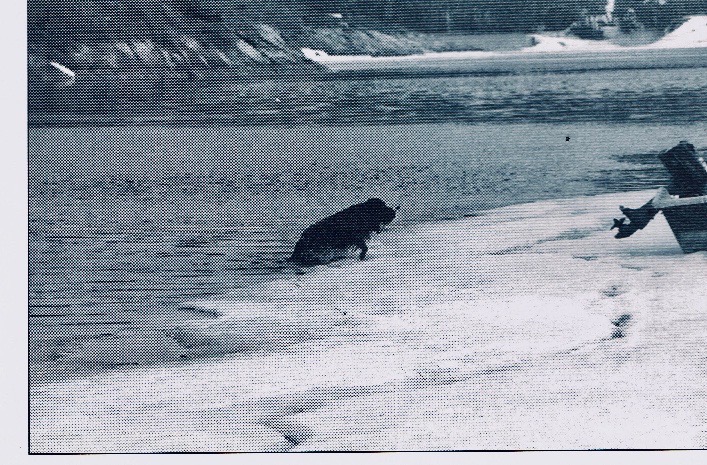
A Flatcoated climbing from the water onto an icy cliff during an early spring shoot on goldeneyes (Bucephala Clangula). (Photo: Tommy Arfman)
Another legendary “workhorse” was Fågelängens Flighty Flee (Celebrity of Ryshot – Hovhills Spirit Girl) a Swedish import bred by Kerstin Eckhardt in 1981 and nicknamed “Liiru”. Her master Timo Blom is a former Finnish junior champion in skeet shooting. He handled Liiru to two Elite Class 1st prizes but then lay off because, as he says, I did not want to ruin my best shooting companion ever. His comments on Scandinavian field trials of those days give a good idea on how different wildfowling in Finland is from formal British type pheasant shoots. A wonderful tribute to the Flatcoated:
Retriever instructors of those days taught the British way, requiring steadiness at heel and formal ways of working which is unsuitable for our wildfowling. I cannot simply ask my dog to sit when I am standing in water up to my waist… I am by no means questioning the relevance of those methods as a rule, but they simply do not fit my purposes.
My first Retriever (“Liiru”) was a real hunter. She surpassed all expectations of the capacity and endurance of a Retriever. I did not succeed to spoil her best qualities although I tried for many years… Several times I’ve waited for more than an hour, in the falling darkness, for that relentless worker who never accepted a lost runner and finally, she stood there in front of the car's headlights with the runner.
Once I shot a duck at a quite long distance, it was winged and started falling. As always, I let Liiru go without a command when the gun was fired. Soon after she arrived with the wounded duck, but I was wondering why she was so exhausted. Later on, my companion told me that the duck had got air under its wings behind the trees and flew further 500 meters to another field. Liiru followed the flying duck as fast as she could and took it when it landed. It convinced me that my working principles are the most relevant ones for my shooting conditions. Contrary to all field trial doctrines my dogs are catching runners faster and more efficiently than a more controlled dog. Against all presumptions this hasn’t made her run in at trials when I don’t shoot myself and tell the dog to stay at heel. (Extracts from Timo Blom´s article in the magazine of the Finnish Retriever Club 3/94)